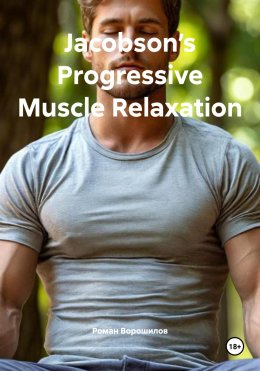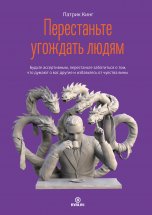Читать онлайн Jacobson’s Progressive Muscle Relaxation

Introduction
Progressive muscle relaxation (PMR) is a method of relieving physical and mental tension by alternately tensing and relaxing different muscle groups. This technique is considered one of the simplest and most accessible relaxation methods to learn. The method was developed by physician and physiologist Edmund Jacobson in the early 1920s, based on the discovery of a close link between muscle tension and a person’s emotional state. In experiments in 1922, Jacobson found that emotions such as fear, anger, anxiety, and panic are accompanied by increased muscle tone, and that by eliminating this muscle tension one can achieve a calmer emotional state. In other words, relaxing the body leads to calming the nervous system, allowing it to regain balance.
Today, Jacobson’s progressive muscle relaxation has become widespread and is used by psychologists and physicians around the world to help people cope with stress and anxiety. The technique is appealing due to its simplicity and effectiveness: it requires no special equipment and can be practiced in almost any setting. Even after the first session, many people experience a noticeable decrease in muscular and emotional tension. With regular practice, a lasting positive effect can be achieved, manifested as improved well-being and greater resilience to stress.
History of Progressive Muscle Relaxation
The development of the progressive relaxation method was the result of many years of scientific research. Edmund Jacobson began studying the relationship between muscle tone and emotions as early as the 1900s, and he summarized his initial findings after about twenty years of research. In 1929, he published a foundational work h2d Progressive Relaxation, in which he presented the theoretical basis and procedures of his method. For the general public, Jacobson prepared a popular version h2d You Must Relax, published in 1934. These books laid the foundation for the progressive muscle relaxation method, describing a stepby-step training course in voluntarily relaxing all the major skeletal muscle groups.
Jacobson’s research continued in the subsequent decades. In the clinical physiology laboratory at the University of Chicago, he refined his technique, and by the 1960s the full training procedure included up to fifteen muscle groups and dozens of practice sessions. Jacobson originally envisioned a very intensive training course: each muscle segment was given from an hour to several hours of daily practice, and the full course comprised over 50 sessions. This approach allowed one to almost completely eliminate involuntary muscle tension and achieve deep relaxation, but it was very labor-intensive and impractical for mass use. In later years, other specialists adapted and simplified the technique. For example, in the 1960s psychologist Joseph Wolpe incorporated progressive relaxation into a behavioral therapy program (systematic desensitization) and cut the training down to a few 20-minute sessions with self-practice at home. Despite the reduction in training time, the basic principle remained the same – sequentially tensing and relaxing muscles under guided instructions, resulting in reduced anxiety and stress responses.
Jacobson’s method quickly gained recognition. The author himself reported that his technique helped with a wide range of disorders, from insomnia and stuttering to depression. In subsequent years, progressive muscle relaxation became firmly established in the arsenal of psychotherapy and self-regulation techniques. It was used both as an independent technique for relaxation and anxiety reduction, and as part of comprehensive programs (for example, to teach stress-management skills, in treating phobias and panic disorders, in rehabilitation of cardiac patients, etc.). Thus, the method’s journey from Jacobson’s initial experiments to its widespread use demonstrates the reliability and effectiveness of progressive relaxation, as confirmed by both clinical practice and scientific research.
Theoretical Foundations of the Method
The progressive relaxation method is based on a key scientific fact: there is a bidirectional connection between the state of our muscles and the activity of our nervous system. Edmund Jacobson was among the first to demonstrate that excessive tension in the skeletal muscles accompanies psychological tension— anxiety, stress, fear. If muscle fibers remain constantly contracted, the sympathetic nervous system is activated, intensifying feelings of anxiety and inner discomfort. Conversely, when deep muscle relaxation is achieved (muscle tone is reduced), the activity of the autonomic nervous system decreases, and one begins to feel a state of calm and emotional comfort. This creates a kind of closed loop: psychological tension causes tightness in the body, and relaxing the body leads to calming the mind. It is precisely this “mind– muscle” interconnection that underlies the progressive muscle relaxation technique.
In the process of Jacobson’s training, a person learns to sense their body more acutely – to recognize even small differences between states of tension and relaxation. Gradually one comes to understand which muscle groups react to certain emotional experiences. For example, in a stressful situation the neck and shoulder muscles might tense up, with anxiety the abdominal muscles might tighten, with anger the jaws and fists clench. By becoming aware of these reactions, a person gains the ability to consciously control them. Progressive relaxation teaches that if you simply relax a tense muscle, the negative emotion will weaken or even disappear. In this way, conscious control is established over the “tension as a response to stress” reaction, and a healthier reflex of relaxation is developed. With regular practice, people report a reduction in overall anxiety, improved mood, and a feeling of control over their own body and emotions. This is a natural result of the training: by reducing physical tension, we directly influence our emotional state, which in turn leads to even greater muscle relaxation – a beneficial cycle is formed.
The Mechanism of Alternating Tension and Relaxation
Why does sequentially tensing and relaxing muscles produce such a pronounced effect? The physiological explanation is related to how the muscular system works. When a muscle actively and maximally contracts for several seconds, it is followed by a phase of post-isometric relaxation – the muscle automatically transitions into a state of deeper relaxation than it was in before the contraction. Simply put, after a strong contraction the muscle fibers let go and remain less tense than usual for a short time. Jacobson utilized this property: by intentionally tensing muscle groups and then abruptly relaxing them, we achieve more complete relaxation than by trying to relax directly without a prior tension phase. It is very important to focus on your sensations during this process: feel the contrast between the state of tension and the subsequent relaxation. It is this contrast that creates a vivid feeling of relaxation that is remembered by the nervous system.
Alternating muscle tension and relaxation also engages different parts of the nervous system. During brief periods of tension, the sympathetic nervous system is activated (responsible for the “fight or flight” response): heart rate increases, blood pressure may rise slightly – the body is primed for action. But as soon as the tension is released, the parasympathetic system takes over, which is responsible for rest and recovery: the heart rate slows, blood vessels dilate, breathing calms. This transition to an internal “rest mode” is subjectively experienced as relaxation, calm, even drowsiness. Thus, alternating tension and relaxation serves as a kind of controlled exercise for the autonomic nervous system, training its flexibility. Over time, practicing progressive relaxation increases the body’s ability to switch from a stress mode to a rest mode. The person becomes less reactive to stressors, and their nervous system recovers more quickly after challenges.
It’s important to note that the technique teaches relaxation voluntarily, at will. In the beginning, you have to perform a special exercise – tensing muscles and then relaxing them – but gradually you develop the ability to quickly release muscle tension without the preliminary effort phase. In other words, later on it will suffice to notice the first signs of tightness in your body and consciously give the command to relax – and your body will respond by shifting into a calmer state. This habit is extremely valuable in daily life: it allows you to prevent an acute stress reaction at the early stages, to “shed” accumulated tension before it grows into intense anxiety or panic.
Preparation for a Relaxation Session
Before you begin the progressive muscle relaxation exercises, it’s important to properly arrange the conditions for your session. Good preparation will help ensure the session is effective and safe.
Choosing the Right Place
Choose a quiet place where you won’t be disturbed for the duration of your relaxation session (usually 10– 20 minutes). Ideally, this will be a calm room with minimal distractions. It’s recommended to dim any harsh lights and turn off the television, phone, and other sources of noise or interruption. Housemates or family members should not bother you – inform them that you need some time alone. Reduce outside noises and sudden stimuli to a minimum.
It’s advisable to ensure a comfortable air temperature. In a room that is too cold, your muscles may tense up involuntarily from shivering, while an overly warm room can cause discomfort that interferes with relaxation. Optimally, the room should be at a moderate, pleasant temperature. Also, make sure there is fresh air: a short while before you begin, you can ventilate the space.
If the setting allows, you may play soft, quiet relaxation music or ambient nature sounds in the background – this can help some people get into the proper mindset. However, the music should not have abrupt changes or lyrics that draw your attention. In general, the atmosphere for practice should be as calm, cozy, and conducive to rest as possible.
Body Position and Comfort
Choosing a comfortable body position during relaxation is very important. There are several options, and each person can find the one that suits them best:
• Lying down. One of the most comfortable options is to lie on your back on a sofa or a mat on the floor. Arms and legs are slightly apart, not crossed, resting freely and symmetrically relative to the body. This position provides maximum relaxation since the muscles aren’t working against gravity. You can place a small flat pillow under your head or a roll under your neck, and a rolled towel under your knees so that your lower back rests more naturally against the surface.
• Semi-reclined in a chair. A comfortable chair with a high back and armrests is a good option if lying down isn’t possible. Your back is supported by the backrest, your head is supported (you can use a neck pillow), arms rest on the armrests, and feet are flat on the floor or on a footrest. In this position, the body is well supported and your muscles can relax.
• Sitting on a chair. If you’re using a regular chair, sit closer to its edge with your feet flat on the floor about shoulder-width apart. Place your hands on your thighs or let them hang loosely at your sides. Keep your back relatively straight but not strained, and hold your head upright or slightly tilted forward. A seated position is less relaxing than lying down, but it can be used, for example, in an office setting. In this case, a “coachman’s pose” is sometimes recommended – where you sit slightly slumped forward, forearms resting on your thighs, and hands dangling between your knees. This pose helps partially relieve the muscles of the back and neck.
No matter which position you choose, the main thing is that you are comfortable and nothing is causing tension. Make sure your clothing doesn’t restrict your movements. Unbuckle any tight belts, collars, or straps, and loosen your tie if you’re wearing one. It’s best to take off your shoes, especially if they’re tight. If you wear glasses, it’s better to remove them so the muscles around your eyes can fully relax. If necessary, remove contact lenses if you plan to do the exercise with eyes closed and find the lenses bothersome. Women should ensure their undergarments are comfortable: for example, a tight bra can create extra tension – it’s better to remove it during the practice.
Prepare anything you might need: perhaps a blanket (if the room is cool and you will be lying still, your body might get chilly), a small pillow for under your head or knees, and a timer or clock (so you don’t have to worry about the time – you could set a timer for the desired session length, or use an audio relaxation track of a set duration). By creating a comfortable environment, you make the task easier for yourself and allow your attention to focus fully on the exercise.
Clothing and Accessories
As mentioned, your clothing during the session should be loose and comfortable. Any tight pieces of clothing can subtly keep muscles tense or distract you. Therefore, before starting, put on something soft that doesn’t restrict you, or loosen and unfasten tight parts of your outfit. Ideally, do PMR in a tracksuit, pajamas, or other comfortable home clothing. If you are in an office or somewhere you cannot fully change, simply loosen your attire as much as possible – remove your jacket, undo the top buttons of your shirt, loosen your belt.
It’s best to remove your shoes entirely. Your feet should rest freely on the floor without anything squeezing them – this way you will better feel the difference between tension and relaxation in your feet. If your feet get cold, you can wear warm socks instead of shoes.
Jewelry and accessories that might interfere should also be taken off. This includes watches with tight straps, bracelets, rings (if you can noticeably feel them on your fingers), ties, belts, hairpins, etc. Women are advised to let their hair down from a tight hairstyle and remove heavy hair clips – the head and neck should be as free as possible.











